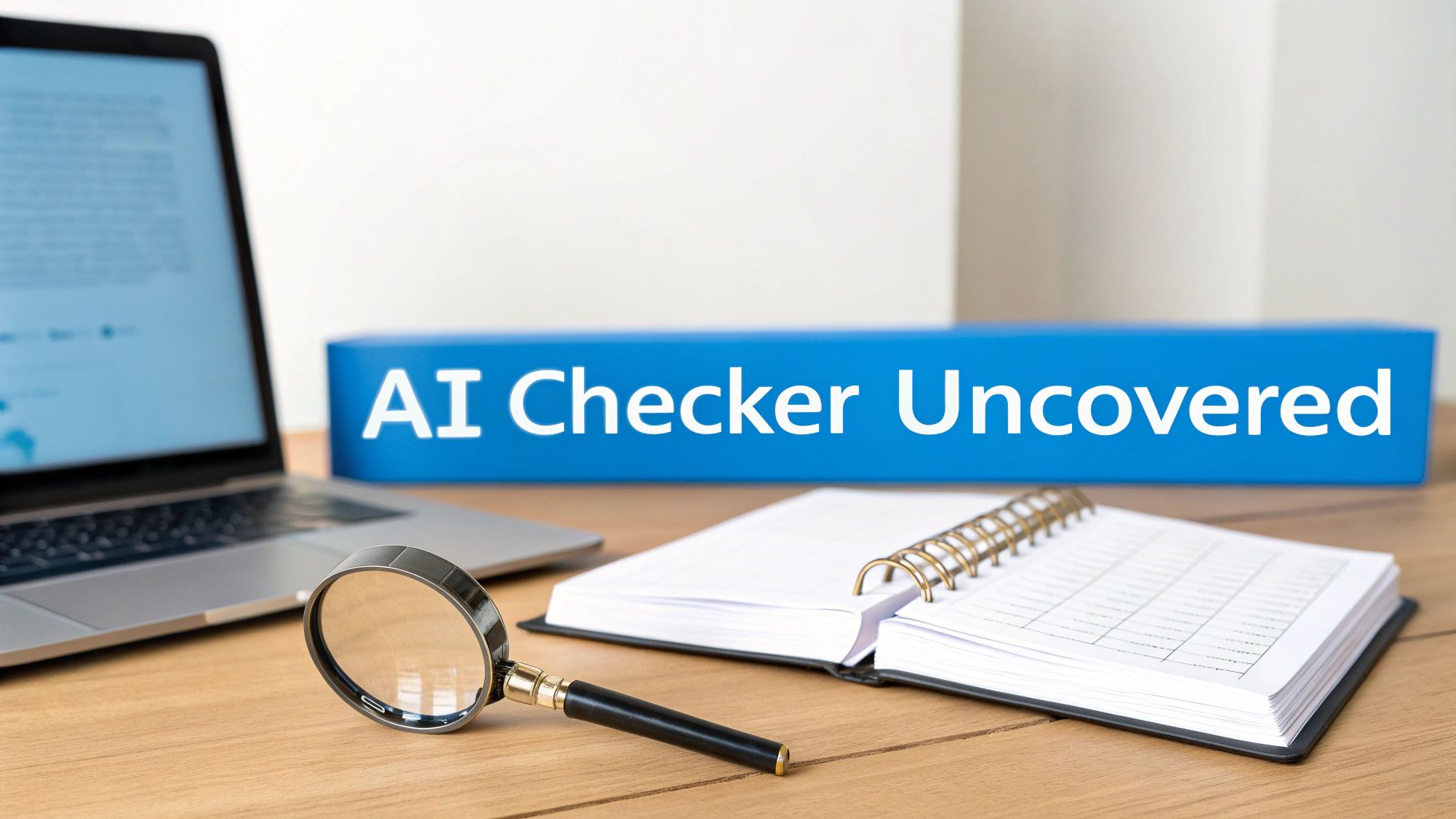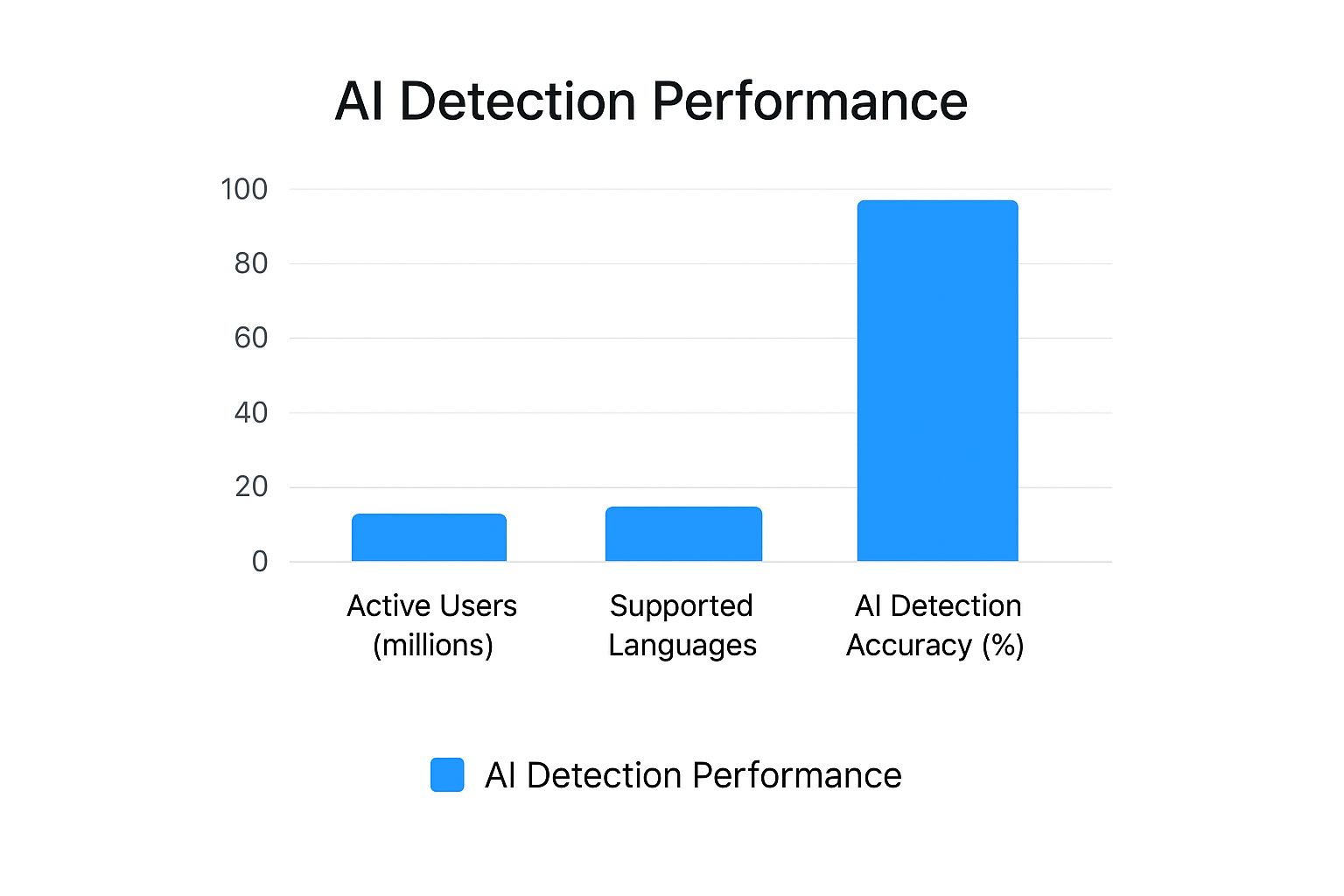Does Grammarly Have an AI Checker? A Clear Look

Yes, Grammarly has an AI checker, but that's not its main job. Think of it as a writing helper first and a content detective second. While it can spot AI-written text to some extent, its main purpose is to help you improve grammar, get the right tone, and write clearly. This makes it very different from tools built only for checking AI content.
Does Grammarly Spot AI Writing? The Short Answer
So, can you count on Grammarly to catch AI writing? The answer isn't a simple yes or no. The platform is full of tools that use AI, but they’re all made to help you write better, not to bust AI-made content. It’s more of a writing coach that polishes your work than an investigator trying to find out where it came from.
This difference is important. Although Grammarly added a function to spot AI writing, its real strength is in improving human-written text. It's great at fixing grammar mistakes, smoothing out sentences, and adjusting your tone.
But if you’re using it just for checking for AI, you might find it lacking. Its design is for assistance, not for deep study of where the text came from. For a closer look at its abilities, you can learn more about the Grammarly AI checker and how it works.
Grammarly's Focus: Assisting vs. Checking
To put it simply, Grammarly's goal is to help you make better content, while a dedicated AI checker's goal is to confirm the origin of existing content. It's a classic case of creation versus validation.
Here's a quick comparison to show the difference:
| Focus | Grammarly's AI | Dedicated AI Checker |
|---|---|---|
| Main Goal | Writing assistance, grammar correction, and tone improvement. | Spotting and flagging text made by AI models. |
| Core Function | To improve and polish human-written content. | To study text patterns and figure out its likely source. |
| Result | Suggestions for making writing clearer, more stylish, and correct. | A score or probability showing if content is AI-made. |
As you can see, their priorities are very different. One helps you build, the other helps you inspect.
If your goal is to make AI-made text sound more human and natural, a specialized tool is almost always the better choice. For instance, a platform like Word Spinner is built specifically to humanize content. Its advanced rewriting capabilities give text a natural feel that sails past AI checkers while ensuring the output is completely original.
The infographic below offers a few key data points on writing tools and their performance in this changing space.
This visual helps frame the balance between a tool's user base, its language support, and the very specific job of checking for AI content.
How Grammarly's AI Actually Works for Writers
To really get what Grammarly can and can't do, it helps to look at how its AI works. At its heart, the platform is built to be a helpful writing coach, not a strict detective trying to trace your content’s origins. Its main job has always been to polish and improve your writing.
Think of it like this: a chef uses a sharp knife to chop vegetables, not to figure out which farm they came from. In the same way, Grammarly’s AI is a tool for improving your work. It goes way beyond basic spell-checking to look at sentence structure, suggest ways to be more concise, and even check the overall tone of your writing.
This focus on help is part of its design. Since its start in 2009, Grammarly has grown from a simple grammar checker for students into a much more advanced writing partner. By 2017, it had launched its first AI-assisted browser extension, and in 2019, it added a tone checker to help writers change their style for different audiences. With 30 million users by 2021, its technology is clearly trusted to help, not investigate.
A Coach, Not a Cop
Grammarly's AI is made to make human writing better. Its main functions all come back to improving what's already on the page—a totally different goal from figuring out if a human wrote it in the first place.
Here’s what its AI is focused on:
- Clarity and Conciseness: It’ll suggest trimming wordy sentences and swapping complex phrases for simpler, clearer ones.
- Tone Adjustment: The AI helps you sound confident, friendly, or formal, depending on what your audience needs.
- Grammar and Spelling: This is its main strength—catching everything from simple typos to tricky grammatical mistakes.
The core idea is partnership. Grammarly works with you to make your message stronger. Its AI is programmed to ask, "How can we make this better?" not "Where did this come from?"
This is exactly why it doesn't work as a dedicated AI checker. Its whole purpose is to help you communicate better, no matter how you wrote the first draft. While it offers a ton of functions, if you're curious about whether Grammarly can completely rephrase your work, you should check out our guide on if Grammarly can rewrite an essay to see its limits. Understanding this difference is key to using the tool the right way.
Writing Assistant vs. AI Checker: What's the Difference?
It’s easy to group writing assistants and AI checkers into the same tech category, but they actually do two completely different jobs. Thinking they’re the same is like confusing a personal trainer with a sports referee—one helps you build your skills, while the other just blows the whistle.
A writing assistant like Grammarly is your partner. It’s built from the ground up to make your writing stronger, clearer, and more impactful. Its entire goal is to polish what you've already created by flagging typos, suggesting better words, or helping you get the right tone. It's a tool for improvement, made to work with you.
An AI checker, on the other hand, plays the role of an investigator. It isn’t there to help you write better; its sole purpose is to scan a finished piece of text for the tell-tale signs that a machine wrote it.
The Coach vs. The Investigator
AI checkers are trained to look for completely different signals than a writing assistant. While a coach like Grammarly helps you find your voice and style, an AI investigator is hunting for clues that give away that it was written by a machine. Gaining a deeper understanding requires understanding the capabilities and limitations of AI as a writer, especially when its output is compared against genuine human creativity.
Here are a few things a dedicated AI checker is looking for:
- Predictable Phrasing: AI models can fall into repetitive sentence structures and rely on overly common word choices, which a checker can easily spot.
- Lack of Personal Voice: AI-made text often feels a bit sterile. It misses the personal quirks, stories, and subtle stylistic choices that make human writing feel real.
- Uniform Complexity: The writing often has a strangely consistent level of complexity, lacking the natural rhythm and change you see when a person writes.
A writing assistant helps you sound more like yourself, just a more polished version. An AI checker's job is to figure out if "you" were even in the room to begin with.
This is the key difference. It's why a tool built for one job can't just flip a switch and do the other. Grammarly's entire system is geared toward polishing human text, not performing a deep study on its origin—that’s a whole different ball game.
Can Grammarly Make AI Content Sound More Human?
This is the big question on a lot of writers' minds right now: if you use AI to get a first draft, can you just run it through Grammarly to make it sound human? The answer isn't a simple yes or no—it’s more of a mixed bag.
Grammarly is great for sanding down the rough edges of AI-made text. It'll catch awkward phrasing, suggest ways to improve clarity, and help you adjust the tone to sound more confident or professional. These little changes definitely make the content flow better and feel more natural to a reader.
But let's be realistic about what it can and can't do. Running an AI-written article through Grammarly alone usually isn't enough to get past a good AI checker. The tool is built to fix common writing errors, not to rewrite the underlying statistical patterns that AI checkers are trained to spot.
The Limits of Polishing
Think of Grammarly as a finishing coat of paint. It can make the surface look clean and polished, but it doesn't change the actual structure of the wall underneath. An AI checker isn't just looking at the surface; it's studying the blueprint of the writing—the predictable word choices and sentence rhythms that show its AI origins.
Grammarly can help you improve AI text, but it won't fundamentally change its DNA. For that, you need a different approach.
For writers who need to be certain their content will pass as human-written, a specialized tool is a much smarter choice. A platform like Word Spinner, for instance, was built from the ground up for this very task. Its advanced rewriting engine is designed to strip out those AI flags, giving the content a genuinely natural feel while ensuring the final output is 100% plagiarism-free.
So, while Grammarly is an incredible assistant for grammar and style, it’s not the magic wand for making AI text sound human. For a deeper dive into what the tool can handle, check out our guide on whether Grammarly can humanize AI text.
Does Grammarly's Plagiarism Checker Find AI Content?
It's a common thought: if a tool can spot copied text, it should be able to sniff out AI writing, right? But that’s a big misunderstanding. Grammarly's plagiarism checker and an AI checker are built to solve two totally different problems.
Think of the plagiarism checker as a literary bloodhound. It scans your document and compares it against a massive library containing billions of web pages and academic papers. If it finds a sentence or paragraph in your text that matches something out there, it flags it.
This method is great for catching old-school cheating, like direct copying or clumsy patchwriting. Its entire job is to find text that already exists somewhere else.
Originality Is the Key Difference
AI-made content, on the other hand, is a whole different ballgame. Tools like ChatGPT create brand-new text for every single prompt. While the information is pulled from its training data, the specific combination of words and sentences is almost always new.
Because of this, AI-written text will sail right through a plagiarism scan without raising any flags. The content is new, so there’s nothing for the checker to match it against. This is a crucial distinction for anyone working in school or content creation.
A plagiarism checker looks for copies of existing work. An AI checker looks for the stylistic fingerprints left behind by a machine. They are hunting for completely different clues.
This means a document can be 100% original according to a plagiarism scan but still be written entirely by an AI. For a deeper dive, it’s worth understanding the core differences between AI detection vs. plagiarism detection and why you might need both.
In the end, relying on a plagiarism tool to find AI content is like using a metal detector to find wooden furniture—it's just not the right tool for the job.
Top Tools for Checking AI-Made Content
Let’s be direct: Grammarly is a powerful writing assistant, but its main job isn't sniffing out AI-made text. If your primary goal is to check whether content was written by a human or a machine, you’ll need a different set of tools.
Luckily, there are some great options out there, built for everyone from teachers grading papers to professional writers who need to guarantee their text's origin.
But there’s a catch. What happens when your content gets flagged? Just knowing a text might be AI-written is only half the battle. If you need to revise that flagged content, you need a specialized rewriter. The standout tool here is Word Spinner. It uses smart technology to humanize text, giving it a natural, conversational feel. It’s built to help you rework content so it can sail through AI checks while staying 100% plagiarism-free.
Finding the Right AI Checker for You
While Grammarly’s AI is busy looking at your text for clarity and correctness, it’s not made to tell you if something was written by an AI like ChatGPT. Its mission has always been about helping people write better, and that focus is clear. You can see it in their global reach across over 100 countries and their $10 million investment in the AI document company Docugami. Their priority is improving writing assistance, not checking, which you can read more about on Grammarly's AI-focused mission page.
Because of this, you’ll want a dedicated tool for checking AI content. Here are a few of the most trusted alternatives:
- Originality.ai: This is the go-to for serious content creators, marketers, and publishers. It’s known for being very thorough and gives you a detailed probability score of AI involvement.
- Copyleaks: A favorite in academic circles, Copyleaks does double duty, checking for both AI content and old-school plagiarism. It's a solid all-in-one for teachers and students who need to cover all their bases.
- GPTZero: What started as a student project has become a hugely popular tool for quick checks on essays and articles. People love its simple interface and straightforward results, making it perfect for quick analysis.
The screenshot below shows just how easy Word Spinner is to use, making it simple to rewrite and humanize your text in a flash.
Its clean layout means you can just paste your content and immediately get to work removing any sign of AI writing.
In the end, the best tool really depends on what you need. If you’re doing a deep dive and need rigorous analysis, Originality.ai is a strong contender. For a quick, reliable check, GPTZero is tough to beat.
Common Questions Answered
When you're navigating the world of writing assistants and AI checkers, a few questions are bound to come up. To get you the answers you need, we’ve put together a list of the most common queries about Grammarly and how it handles AI-made text.
Is Grammarly Planning to Add a Dedicated AI Checker?
While Grammarly is constantly rolling out new updates, its core focus has always been on being the best writing partner possible. The company hasn't announced any official plans to launch a standalone AI content checker.
At its heart, Grammarly's mission is to help people write better, no matter where the first draft came from.
Can My Teacher Tell If I Used Grammarly on an AI Essay?
A teacher won't know you've used Grammarly itself—the tool just polishes up your grammar, spelling, and tone. It's like having a proofreader look over your work.
However, if the original essay was written by AI, it might still carry those subtle, robotic patterns that a sharp-eyed teacher or a proper AI checker can spot. Grammarly makes the writing better, but it doesn't fundamentally change its AI origins.
A Quick Note on Privacy: Before uploading sensitive documents to any online tool, including AI checkers, take a minute to review their terms of service. You'll want to understand exactly how your data is handled to keep your information secure.
Is It Safe to Use AI Checkers for Confidential Documents?
You should always be careful. When you upload a document to an online service, you're playing by their rules and agreeing to their privacy policy. Some services might store your data or even use it to train their models.
For anything sensitive or confidential, it’s absolutely necessary to read the terms of service for any AI checker you use. Always lean towards tools with strong, clear privacy policies.
When you need to be absolutely sure your content sounds human and sails past AI checks, Word Spinner is the way to go. Its specialized rewriting engine gives your text a genuine human touch, ensuring it’s both authentic and original. Give it a try at https://word-spinner.com.


